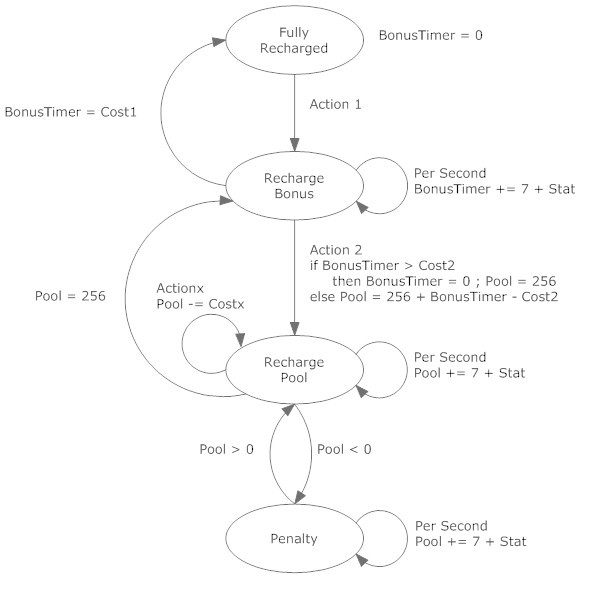The Wiki for Tale 5 is in read-only mode and is available for archival and reference purposes only. Please visit the current Tale 11 Wiki in the meantime.
If you have any issues with this Wiki, please post in #wiki-editing on Discord or contact Brad in-game.
Users:Neurfur/StatTimer
Below is a theory I have put together on how the stat timers work in T5. Feel free to stress test this and prove me wrong.
Definitions
Bonus - An action that does not take any resources from the pool. There is only 1 bonus action.
Pool - A buildup of points that can be expended to do an action or multiple actions. Size is fixed at 256.
Penalty - A period of time where an action requiring a certain stat cannot be performed. That stat is bright red in the skills tab.
Cost - The cost of an action. Cost is equal to 7 * the timer. Base timer numbers can be found here. Costs never change.
Stat - The number assigned to a certain stat. Typically 0-7, but can be higher on food.
Model
Conclusions
- You cannot cheat the timer. You must wait an equal amount of time that the actions cost. However...
- The timer can cheat you. If your first action has a high cost, you wait until you almost have your bonus back, then do a small cost action. Any leftover time in the BonusTimer is lost.
- Higher stats do not let you do more actions or queue up more points. It simple refills your Pool and BonusTimer faster. Therefore...
- In burst mode, someone with 0 stats can do just as many actions as someone with high stats. The difference is the higher stat player will be ready to burst actions sooner.
- If you are fully recharged, you are guaranteed 2 actions, regardless of the cost.
- The timer is clientside.
Proof
A series of experiments used to test and understand each part of the model. All tests are performed fully recharged.
- Stats do not lower the cost.
Stat0 : 60s -> 60s = 23s penalty
Stat2 : 60s -> 60s = 18s penalty
Using a cost reduction model of 7/(7+stat), the anticipated penalty would be 10s.
- Stats do not increase the pool.
Stat0 : 40s -> 40s = 3s penalty
Stat2 : 40s -> 40s = 3s penalty
If the size of the pool had gone up, the penalty would be lower.
- Timer is clientside.
Stat0 : 60s -> 40s wait -> 60s ->60s = 43s timer.
If the timer was server side, an error of about 10% would be expected (slower timer). A rounding error of a second is acceptable for clientside timing.
